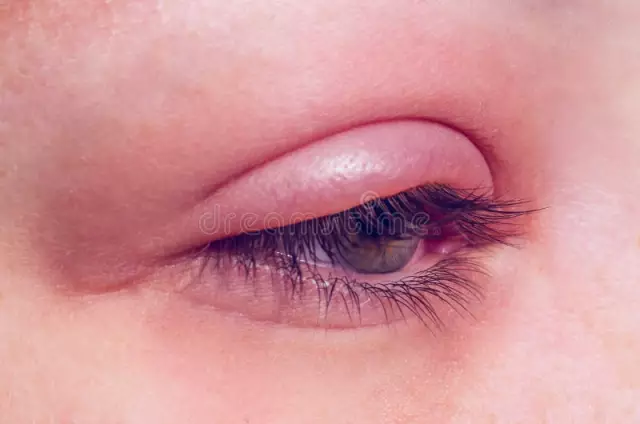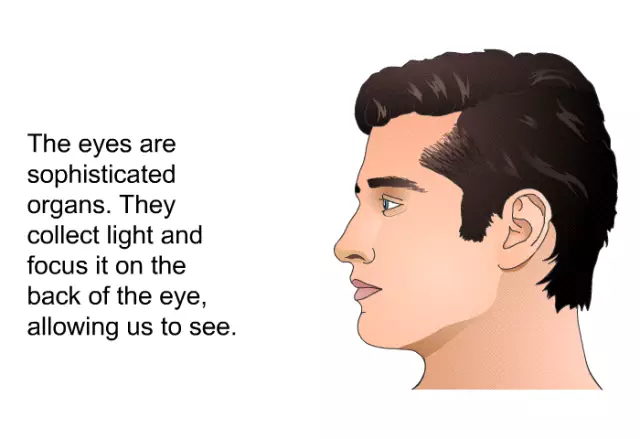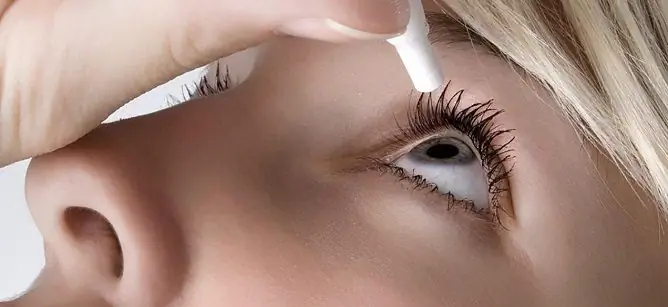- Author Rachel Wainwright [email protected].
- Public 2023-12-15 07:39.
- Last modified 2025-11-02 20:14.
Prolatan
Prolatan: instructions for use and reviews
- 1. Release form and composition
- 2. Pharmacological properties
- 3. Indications for use
- 4. Contraindications
- 5. Method of application and dosage
- 6. Side effects
- 7. Overdose
- 8. Special instructions
- 9. Application during pregnancy and lactation
- 10. Use in childhood
- 11. Drug interactions
- 12. Analogs
- 13. Terms and conditions of storage
- 14. Terms of dispensing from pharmacies
- 15. Reviews
- 16. Price in pharmacies
Latin name: Prolatan
ATX code: S01EE01
Active ingredient: latanoprost (latanoprost)
Manufacturer: SENTISS PHARMA Pvt. Ltd (India)
Description and photo update: 2018-21-11
Prices in pharmacies: from 300 rubles.
Buy

Prolatan is an antiglaucoma drug.
Release form and composition
Dosage form of Prolatan - eye drops: colorless transparent solution (in a polyethylene bottle with a dropper cap 2.5 or 5 ml, in a cardboard box 1 or 3 bottles).
Composition of 1 ml solution:
- active substance: latanoprost - 0.05 mg;
- auxiliary components: benzalkonium chloride, sodium chloride, anhydrous disodium hydrogen phosphate, sodium dihydrogen phosphate monohydrate, water for injection.
Pharmacological properties
Pharmacodynamics
The active substance of Prolatan - latanoprost, which is an analogue of prostaglandin F 2α and a selective agonist of FP-receptors, helps to reduce intraocular pressure, which is due to an increase in the outflow of aqueous humor mainly through the uveoscleral tract, to a lesser extent through the trabecular network.
The decrease in intraocular pressure begins approximately 3-4 hours after the local administration of latanoprost, the maximum effect is achieved after 8-12 hours. The effect of the drug lasts for at least one day.
Latanoprost has no significant effect on the blood-ophthalmic barrier and on the production of aqueous humor. When used in therapeutic doses, the active substance does not show a significant pharmacological effect on the respiratory and cardiovascular systems.
Pharmacokinetics
- absorption: being a prodrug, latanoprost is absorbed through the cornea of the eye, where it is hydrolyzed from the ester to biologically active acids. The maximum concentration (C max) in aqueous humor is reached approximately 2 hours after topical application of Prolatan;
- distribution: the volume of distribution (V d) is 0.16 ± 0.02 l / kg. Latanoprost acids are determined in aqueous humor during the first four hours, in blood plasma - only during the first hour after local administration;
- metabolism: biologically active acids of latanoprost, entering the systemic circulation, are metabolized mainly in the liver by beta-oxidation of fatty acids, forming 1,2,3,4-tetranor- and 1,2-dinor-metabolites;
- excretion: latanoprost acids are rapidly excreted from blood plasma with a half-life (T 1/2) of 17 minutes. Systemic clearance is about 7 ml / min / kg. After the Knoop-Linen cycle, metabolites are excreted in the liver mainly by the kidneys - as a result of topical application, approximately 88% of the administered dose is excreted in the urine.
In children aged 3 to 12 years, the exposure of latanoprost is approximately 2 times higher than in adult patients, in children under 3 years of age - 6 times higher than in adults. The safety profile of Prolatan, however, is the same in children and adults. The time to reach C max of latanoprost acids in blood plasma is 5 minutes for all age groups. T 1/2 also has the same meaning in children and adults.
In the equilibrium concentration, the accumulation of latanoprost acids in the blood plasma does not occur.
Indications for use
According to the instructions, Prolatan is indicated for use in open-angle glaucoma or increased ophthalmotonus to reduce increased intraocular pressure in adults and children over 1 year old.
In children under 3 years of age with primary congenital glaucoma, first-line therapy remains surgical treatment (goniotomy / trabeculotomy).
Contraindications
Absolute:
- age up to 1 year;
- increased individual sensitivity to latanoprost or any of the auxiliary components of the drug.
Relative (the use of Prolatan requires caution):
- neovascular, inflammatory or congenital glaucoma (due to the lack of sufficient experience of use);
- aphakia and pseudoaphakia with damage to the posterior capsule of the lens;
- diseases / conditions in which there are risk factors for macular edema (cases of development of macular edema, including cystoid, during therapy with latanoprost are described);
- a history of herpetic keratitis;
- conditions with an increased risk of developing uveitis and / or iritis;
- asthma;
- planned surgery for cataracts (due to insufficient data on the use of the drug);
- pregnancy and lactation.
The use of Prolatan should be avoided in patients with active herpetic keratitis and recurrent herpetic keratitis, especially associated with the use of prostaglandin analogues.
Instructions for use of Prolatan: method and dosage
Prolatan eye drops are applied topically. The optimal effect is achieved when the drug is administered in the evening. To reduce the possible systemic effect of latanoprost, immediately after installation of each drop, press for one minute on the lacrimal opening located at the inner corner of the eye in the lower eyelid.
Adults and children over 1 year old are advised to instill 1 drop in each affected eye once a day.
Side effects
Possible side effects from systems and organs:
- organ of vision: eye irritation (itching, feeling of sand in the eyes, tingling, burning sensation, sensation of a foreign body), conjunctival hyperemia, blepharitis, increased iris pigmentation, eye pain, eyelid edema, edema and erosion of the cornea, periorbital edema, transient pinpoint erosion epithelium, conjunctivitis, uveitis / iritis, keratitis, macular edema (including cystoid), photophobia, blurred vision, dryness of the mucous membrane of the eyes, thickening, lengthening, increased pigmentation and an increase in the number of eyelashes and vellus hair, a change in the direction of eyelash growth, causing some cases of eye irritation;
- skin and subcutaneous tissues: local skin reactions on the eyelids and darkening of the eyelid skin, rash, toxic epidermal necrolysis;
- nervous system: dizziness, headache;
- respiratory organs: shortness of breath, bronchospasm (including acute attacks or exacerbation of the disease in patients with a history of bronchial asthma);
- musculoskeletal system and connective tissue: joint and / or muscle pain;
- local and general reactions: nonspecific chest pain;
- others: the development of herpetic keratitis.
In some cases, patients with diabetic retinopathy developed retinal artery embolism, retinal detachment, and vitreous hemorrhage.
Fever and nasopharyngitis were most common in children compared with adults.
Overdose
In case of an overdose of latanoprost, irritation of the mucous membrane of the eye may occur, as well as the development of hyperemia of the episclera or conjunctiva.
In case of unintentional intake of Prolatan inside, it must be borne in mind that 2.5 ml of eye drops contain 125 μg of latanoprost, 5 ml - 250 μg. During the first passage through the liver, 90% of the active substance is metabolized. Intravenous administration of a dose of 3 μg / kg of body weight in healthy volunteers did not cause any symptoms, however, administration of a dose of 5.5 to 10 μg / kg led to the development of such negative reactions as nausea, abdominal pain, fatigue, dizziness, sweating and tides. In patients with moderate bronchial asthma, when a dose of latanoprost was injected into the eyes, exceeding the therapeutic dose by 7 times, bronchospasm was not observed.
In cases of overdose, symptomatic treatment is recommended.
special instructions
Prolatan eye drops should be used no more than once a day, since more frequent installations of latanoprost weaken the effect that reduces intraocular pressure.
If the next instillation is missed, the next dose should be administered as usual.
It is possible to simultaneously use Prolatan with other ophthalmic preparations for topical use with the effect of reducing intraocular pressure. In this case, the interval between the introduction of eye drops should be at least 5 minutes.
Since benzalkonium chloride, which is part of the drug, is able to be absorbed by eye contact lenses, the lenses must be removed before instilling the solution. They should be installed back no earlier than 15 minutes after instillation.
Prolatan can lead to a gradual increase in the content of brown pigment in the iris, which is due to an increase in the content of melanin in the stromal melanocytes of the iris, and not an increase in the number of melanocyte cells themselves. Most often, brown pigmentation occurs around the pupil and spreads to the periphery of the iris concentrically, while the iris becomes brown in part or in whole. As a rule, discoloration is not significant and may not be clinically established. Increased pigmentation is observed mainly in patients with a mixed iris color, which is dominated by brown pigment. Eye drops do not affect lentigines and iris nevi. The pigment does not accumulate in the anterior chamber of the eye or in the trabecular meshwork.
There were no undesirable consequences of an increase in pigmentation even with long-term treatment with latanoprost when studying the degree of pigmentation of the iris for more than five years. The degree of decrease in intraocular pressure did not depend on the presence or absence of increased pigmentation, from which it follows that Prolatan therapy can be continued even with increased iris pigmentation. Such patients require regular monitoring, and in the event of a worsening clinical situation, discontinuation of drug treatment.
Studies have shown that an increase in the pigmentation of the iris is usually observed during the first year of treatment with latanoprost, during the next two years - rarely. After the fourth year of therapy, no effect was observed. The rate of progression of pigmentation decreases over time and stabilizes after 5 years. In more distant time periods, the effect of enhanced iris pigmentation has not been studied. After withdrawal of Prolatan, no increase in brown pigmentation was observed, however, the change in the color of the iris of the eyes may be irreversible.
Cases of darkening of the eyelid skin with the introduction of latanoprost, which can be reversible, have been described. Changes in eyelashes and vellus hair (thickening, lengthening, increasing density, changing the direction of growth and increased pigmentation) disappear after stopping the use of Prolatan.
Patients who inject eye drops into only one eye may develop heterochromia.
Influence on the ability to drive vehicles and complex mechanisms
The use of Prolatan can cause transient blurred vision. Therefore, care must be taken when driving and performing work with an increased risk of accidents.
Application during pregnancy and lactation
Due to the lack of adequate controlled studies of the use of Prolatan in pregnant women, it should be prescribed only in cases where the expected benefit to the mother is higher than the possible risk to the fetus.
During lactation, the drug should be used with caution due to the possible release of latanoprost and its metabolites into breast milk.
Pediatric use
Prolatan is contraindicated in children under 1 year of age.
Drug interactions
With the simultaneous use of two analogs of prostaglandins for instillation into the eyes, cases of a paradoxical increase in intraocular pressure have been described, therefore, the joint use of two or more prostaglandins, their derivatives or analogs is not recommended.
Latanoprost is pharmaceutically incompatible with thiomersal-containing eye drops due to a precipitation reaction.
Analogs
Prolatan's analogs are: Glaumax, Glauprost, Ksalatan, Xalatamax, Lanotan, Latanoprost, Latanoprost-Teva, Trilaktan and others.
Terms and conditions of storage
Store in a dark place at a temperature of 2 to 8 ° C.
Keep out of the reach of children.
Shelf life - 2 years, after opening the bottle - 45 days at a temperature not exceeding 25 ° C.
Terms of dispensing from pharmacies
Dispensed by prescription.
Reviews about Prolatan
At the moment, users have not left any reviews about Prolatan, by which one could judge any qualities of eye drops.
Price for Prolatan in pharmacies
The price of Prolatan for a 2.5 ml bottle is approximately 490 rubles.
Prolatan: prices in online pharmacies
|
Drug name Price Pharmacy |
|
Prolatan 0.005% eye drops 2.5 ml 1 pc. RUB 300 Buy |
|
Prolatan eye drops 0.005% 2.5ml 552 r Buy |
|
Prolatan 0.005% eye drops 2.5 ml 3 pcs. 1015 RUB Buy |

Anna Kozlova Medical journalist About the author
Education: Rostov State Medical University, specialty "General Medicine".
Information about the drug is generalized, provided for informational purposes only and does not replace the official instructions. Self-medication is hazardous to health!






